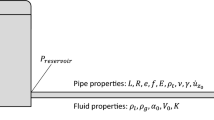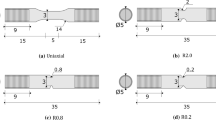Abstract
This paper presents a computational model for the fluid dynamics in a fractured ductile pipe under high pressure. The pressure profile in front of the crack tip, which is the driving source of crack propagation, is computed using a nonlinear wave equation. The solution is coupled with a one dimensional choked flow analysis behind the crack. The simulation utilizes a high order optimized prefactored compact–finite volume method in space, and low dispersion and dissipation Runge–Kutta in time. As the pipe fractures the rapid depressurization take place inside the pipe and the propagation of the crack-induced waves strongly influences the outflow dynamics. Consistent with the experimental observation, the model predicts the expansion wave inside the pipe, and the reflection and outflow of the wave. The model also helps characterize the propagation of the crack dynamics and fluid flows around the tip of the crack.
Similar content being viewed by others
References
Cullen, W.D.: The Public Inquiry into the Piper Alpha Disaster. Department of Energy, HMSO, London (1990)
Mahgereteh, H.: An analysis of the gas pipeline explosion at Ghislenghien. In: Belgium 40th Loss Prevention Symposium (T5) (2006)
Mahgereteh H., Oke A., Atti O. (2006) Modelling outflow following rupture in pipeline networks. Chem. Eng. Sci. 61: 1811–1818
Mahgerefteh H., Oke A., Rykov Y. (2006) Efficient numerical solution for highly transient flows. Chem. Eng. Sci. 61: 5049–5056
Mahgerefteh H., Saha P., Economou I.G. (1999) Fast numerical simulation for full bore rupture of pressurized pipelines. A.I.Ch.E. J. 45(6): 1191
Zhou, J., Adewuni, M.A.: Simulation of transient flow in natural gas pipelines. In: 27th Annual Meeting PSIG, Albuquerque, New Mexico (1995)
Cumber P.S. (2007) Outflow from fractured pipelines transporting supercritical ethylene. J. Loss Prev. Process Ind. 20: 26–37
Greenshields G.J., Venizelos G.P., Ivankovic A. (2000) A fluid-structure model for brittle fracture in plastic pipes. J. Fluid Struct. 14: 221–234
Terenzi A. (2005) Influence of real-fluid properties in modelling decompression wave interacting with ductile fracture propagation. Oil Gas Sci. Technol. Rev. IFP 60(4): 711–719
Shyy W. (1985) A study of finite difference approximations to steady-state, convection-dominated flow problems. J. Comput. Phys. 57: 415–438
Shyy, W.: Computational Modeling for Fluid Flow and Interfacial Transport. Elsevier, Amsterdam (1994) (revised printing 1997)
Hu F.Q., Hussaini M.Y., Manthey J.L. (1996) Low dissipation and dispersion Runge-Kutta for computational acoustics. J. Comput. Phys. 124: 177–191
Stanescu D., Habashi W.G. (1998) 2N-storage low dissipation and dispersion Runge-Kutta for computational acoustics. J. Comput. Phys. 143: 674–681
Wang, G., Sankar, L.N.: Prediction of rotorcraft noise with a low-dispersion finite volume scheme. AIAA-99-0480 (1999)
Cheong C., Lee S. (2001) Grid-optimized dispersion-relation-preserving schemes on general geometries for computational aeroacoustic. J. Comput. Phys. 174: 248–276
Wang Z.J., Chen R.F. (2001) Optimized weighted essentially nonoscillatory schemes for linear waves with discontinuity. J. Comput. Phys. 174: 381–404
Ashcroft G., Zhang X. (2003) Optimized prefactored compact scheme. J. Comput. Phys. 190: 459–477
Popescu M., Shyy W., Garbey M. (2005) A study of dispersion-relation-preserving and optimized prefactored compact schemes for wave equation. J. Comput. Phys. 210(5): 705–729
Popescu M., Vedder R., Shyy W. (2008) A finite volume-based high order, Cartesian cut-cell method for wave propagation. Int. J. Numer. Methods Fluids 56: 1787–1818
Aihara, S., Østby, E., Lange, H.I., Misawa, K., Yasuhito, I., Thaulow, C.: Burst test for high-Pressure hydrogen gas line pipes. In: IPC2008, 7th International Pipeline Conference (2008) (submitted paper)
Liepmann H.W., Roshko A. (1957) Element of Gasdynamics. Wiley, New York, pp 53–54
Zhuang Z., Gua Y. (1999) Analysis of dynamic fracture mechanism in gas pipeline. Eng. Fract. Mech. 64: 271–289
Author information
Authors and Affiliations
Corresponding author
Rights and permissions
About this article
Cite this article
Popescu, M. Modeling of fluid dynamics interacting with ductile fraction propagation in high pressure pipeline. Acta Mech Sin 25, 311–318 (2009). https://doi.org/10.1007/s10409-009-0244-8
Received:
Accepted:
Published:
Issue Date:
DOI: https://doi.org/10.1007/s10409-009-0244-8




